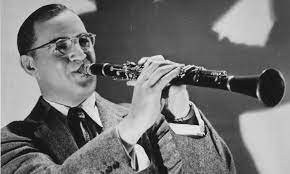Benny Goodman: The King of Swing
Introduction
Benny Goodman, a name synonymous with the swing era, was more than just a jazz clarinetist—he was a cultural trailblazer who changed the face of American music. From humble beginnings to global stardom, Goodman’s clarinet playing blended jazz, blues, and classical elements in a way few others had done before. Known as the “King of Swing,” he broke racial barriers, led one of the first racially integrated bands in America, and brought jazz and blues-inspired music to the forefront of American consciousness during the 1930s and 1940s.
Goodman’s musical genius was defined not only by his technical mastery but also by his boldness in challenging social norms. He brought the soulful essence of blues into big band arrangements and made improvisation a central element of popular music. His legacy continues to shape the jazz and blues landscape today.

Childhood
Benjamin David Goodman was born on May 30, 1909, in Chicago, Illinois, the ninth of twelve children born to poor Jewish immigrants from the Russian Empire. His father, David Goodman, worked as a tailor and encouraged his children to pursue music as a means of improving their lives.
Benny showed early musical talent, and at the age of 10, he began taking clarinet lessons at the Kehelah Jacob Synagogue and later at Hull House, a progressive settlement home that offered free music lessons to underprivileged children. His first formal instructor was Franz Schoepp, a noted classical clarinetist, who instilled in him a discipline and technique that would serve him throughout his career.
By the age of 12, Benny was already performing professionally, playing in dance bands and earning money to help support his family. Chicago in the 1920s was a hotbed of jazz, and the young Goodman was exposed to the raw, emotional power of blues and jazz through local performers and visiting stars.
Youth
As a teenager, Goodman joined the musicians’ union and began performing with prominent Chicago bands. His big break came in 1925 when he joined the Ben Pollack Orchestra, a well-known jazz group. With Pollack, Goodman made his first recordings and began to develop his signature style: a brilliant, fast, and fluid clarinet sound with deeply bluesy undertones.
Goodman moved to New York in the late 1920s, where he worked as a studio musician, recording with jazz and blues artists and honing his arranging skills. By the early 1930s, he had become a fixture in the city’s thriving music scene.
He was influenced by—and collaborated with—key African American musicians of the era, including Fletcher Henderson, whose arrangements would later fuel Goodman’s rise to stardom. Goodman’s deep appreciation for the blues was evident in his playing, which often featured long, emotive lines and improvisational phrasing drawn directly from blues tradition.
Adulthood
In 1934, Benny Goodman formed his own big band and began recording for RCA Victor. That same year, he secured a spot on the nationally broadcast radio show “Let’s Dance.” Though initially not widely successful, the band’s popularity skyrocketed after a 1935 performance at the Palomar Ballroom in Los Angeles. This concert is often cited as the beginning of the Swing Era.
Goodman’s band featured many prominent musicians, including Gene Krupa on drums, Harry James on trumpet, and Teddy Wilson on piano. In 1936, Goodman made history by hiring Wilson, an African American pianist, into his trio—an almost unheard-of move at the time in segregated America. Later, he added vibraphonist Lionel Hampton, creating one of the first racially integrated bands to perform publicly.
The band’s music was a fusion of upbeat swing rhythms and deeply rooted blues motifs. Songs like “Sing, Sing, Sing” and “Don’t Be That Way” showcased Goodman’s clarinet soaring over rich horn sections, punctuated by blues-inspired phrasing and improvisation.
Goodman’s landmark 1938 concert at Carnegie Hall helped to legitimize jazz as a serious art form. It was one of the first times jazz had been performed in such a prestigious venue and included performances of both swing and blues classics.
Major Compositions and Contributions
While Benny Goodman was not primarily a composer, his recordings and arrangements left a lasting mark on American music. Among his most notable pieces are:
- “Sing, Sing, Sing (With a Swing)” – Originally composed by Louis Prima, Goodman’s arrangement turned this piece into a swing anthem, with a powerful drum solo and bluesy clarinet lines.
- “Stompin’ at the Savoy” – A jazz standard closely associated with Goodman, this piece was based on Harlem dance hall rhythms and showcased blues harmonies and swing rhythms.
- “Moonglow” – A romantic, blues-infused tune that became one of Goodman’s signature numbers.
- “Don’t Be That Way” – Composed by Edgar Sampson but popularized by Goodman, this song combined swing energy with blues melancholy.
In addition to popular tunes, Goodman also made significant contributions to classical music, commissioning works from composers like Béla Bartók and Aaron Copland, and proving the versatility of the clarinet beyond swing and blues.
Death
Benny Goodman remained active into the 1980s, touring and recording well into his 70s. He passed away on June 13, 1986, in New York City, at the age of 77 from a heart attack.
At the time of his death, tributes poured in from around the world. Musicians, critics, and fans alike praised his technical brilliance, his courage in integrating his bands, and his role in elevating jazz and blues to new heights of popularity and respectability.
Conclusion
Benny Goodman’s influence on American music is both profound and enduring. As the “King of Swing,” he brought jazz and blues to mainstream audiences and changed the way Americans thought about popular music. His commitment to musical excellence, racial integration, and stylistic innovation helped shape the sound of the 20th century.
Though best remembered for his contributions to swing jazz, Goodman’s music was deeply rooted in the blues. His phrasing, improvisation, and collaborations with African American musicians reflect a lifelong engagement with the blues tradition. His legacy continues to inspire generations of musicians across genres.

Comments are closed